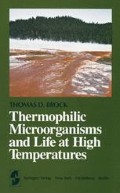Abstract
The Firehole River, which flows through the main geyser basins of Yellowstone National Park (Figure 13.1), has been the main avenue of tourist travel through Yellowstone for over 100 years. It would be a remarkable river in any setting, but here in the valley of the geysers, its beauty and excitement are unsurpassable. Immediately as one glimpses the Firehole through the trees during the descent into the Upper Geyser Basin, one knows that this is not an ordinary mountain river, but something special. However, the Firehole River is more than a tourist attraction: it is of great scientific interest because it is the best example known of a naturally thermally polluted river. In these days when the long-range consequences of environmental pollution are constantly debated, it is not difficult to see the value for study of a river such as the Firehole, which has been receiving thermal inputs for hundreds of years and may, consequently, reveal to us something about how ecosystems can adapt to pollutants, given enough time. And the Firehole is especially interesting when it is understood that despite the fact that its temperature is raised almost 15°C as a result of thermal inputs (about what the largest power plant could do to its cooling water), it is still considered an excellent trout stream, one that attracts fly fishermen from all over the world.
Access this chapter
Tax calculation will be finalised at checkout
Purchases are for personal use only
Preview
Unable to display preview. Download preview PDF.
References
Allen, E. T. and A. L. Day. 1935. Hot Springs of the Yellowstone National Park. Carnegie Institution of Washington Publication No. 466, Washington, D.C. 525 pp.
Argyle, R. 1966. Thermal Dispersion in Lotic Waters of Yellowstone National Park. Masters thesis. Colorado State University, Fort Collins. 122 pp.
Armitage, K. B. 1958. Ecology of the riffle insects of the Firehole River, Wyoming. Ecology 39, 571–580.
Armitage, K. B. 1961. Distribution of riffle insects of the Firehole River, Wyoming. Hydrobiologia 17, 152–174.
Benson, N. G., Cope. O. B., and Bulkley, R. V. 1959. Fishery Management Studies on the Madison River System in Yellowstone National Park. Special Scientific Report-Fisheries No. 307, United States Dept. of Interior Fish and Wildlife Service, 29 pp.
Bonney, O. H. and L. Bonney. 1970. Battle Drums and Geysers. The Swallow Press, Inc., Chicago, 622 pp.
Bott, T. L. and T. D. Brock. 1969. Bacterial growth rates above 90°C in Yellowstone hot springs. Science 164, 1411–1412.
Boylen, C. W. and T. D. Brock. 1973. Effects of thermal additions from the Yellowstone geyser basins on the benthic algae of the Firehole River. Ecology 54, 1282–1291.
Brock, T. D. 1975. Predicting the Long-Range Consequences of Thermal Pollution from Studies on Natural Geothermal Systems. International Atomic Energy Agency Symposium, Oslo, Norway, published by I.A.E.A., Vienna, Austria, pp. 599–622.
Brock, T. D. and K. L. Boylen. 1973. Presence of thermophilic bacteria in laundry and domestic hot-water heaters. Appl. Microbiol. 25, 72–76.
Brock, T. D., M. L. Brock, T. L. Bott, and M. R. Edwards. 1971. Microbial life at 90 C: the sulfur bacteria of Boulder Spring. J. Bacteriol. 107, 303–314.
Brock, T. D. and H. Freeze. 1969. Thermus aquaticus gen.n. and sp.n., a non-sporulating extreme thermophile. J. Bacteriol. 98, 289–297.
Brock, T. D. and I. Yoder. 1971. Thermal pollution of a small river by a large university: bacteriological studies. Proc. Indiana Acad. Sci. 80, 183–188.
Brock, T. D. and J. Hoffman. 1974. Temperature optimum of algae living in the outfall of a power plant on Lake Monona. Trans. Wis. Acad. Sciences, Arts and Letters 62, 195–203.
Chittenden, H. M. 1964. The Yellowstone National Park. Edited and with an introduction by R. A. Bartlett, from the 1895 edition. University of Oklahoma Press, Norman, 208 pp.
Deacon, J. E. and W. L. Minckley. 1974. Desert fishes. In Desert Biology, Vol. II, G. W. Brown, Jr., ed. Academic Press, New York, pp. 385–488.
Jordan, D. S. 1889. A reconnaissance of the streams and lakes of the Yellowstone National Park, Wyoming, in the interest of the United States Fish Commission. Bull. U.S. Fish Comm. 9, 41–63.
Langford, N. P. 1870. The Discovery of Yellowstone Park. Reprinted by University of Nebraska Press, Lincoln, 1872, Foreword by A. L. Haines, 125 pp.
Roeder, T. S. 1966. Ecology of the diatom communities of the upper Madison River system, Yellowstone National Park. Ph.D. dissertation, Montana State University, Bozeman.
Santaniello, R. M. 1971. Water quality criteria and standards for industrial effluents. In Industrial Pollution Control Handbook, H. F. Lund, ed. McGraw-Hill, New York, pp. 4–23–4–40.
Sharpe, F. P. 1970. Yellowstone Fish and Fishing. Yellowstone Library and Museum Association, 49 pp. (Available from the Yellowstone National Park, Wyoming.)
Snyder, G. R. 1969. Heat and anadromous fishes. Discussion of paper by R. E. Nakatani. In Biological Aspects of Thermal Pollution, P. A. Krenkel and F. L. Parker, eds. Vanderbilt University Press, Nashville, Tenn., pp. 318–337.
Todd, E. H. 1967. Primary productivity of the Madison River in Yellowstone National Park, Wyoming. Ph.D. dissertation, Montana State University, Bozeman.
Wright, J. C. and R. M. Horrall. 1967. Heat budget studies on the Madison River, Yellowstone National Park. Limnol. Oceanogr. 12, 578–583.
Wright, J. C. and I. K. Mills, 1967. Productivity studies on the Madison River, Yellowstone National Park. Limnol. Oceanogr. 12, 568–577.
Zeikus, J. G. and T. D. Brock. 1972. Effects of thermal additions from the Yellowstone geyser basins on the bacteriology of the Firehole River. Ecology 53, 183–290.
Author information
Authors and Affiliations
Rights and permissions
Copyright information
© 1978 Thomas D. Brock
About this chapter
Cite this chapter
Brock, T.D. (1978). The Firehole River. In: Thermophilic Microorganisms and Life at High Temperatures. Springer Series in Microbiology. Springer, New York, NY. https://doi.org/10.1007/978-1-4612-6284-8_13
Download citation
DOI: https://doi.org/10.1007/978-1-4612-6284-8_13
Publisher Name: Springer, New York, NY
Print ISBN: 978-1-4612-6286-2
Online ISBN: 978-1-4612-6284-8
eBook Packages: Springer Book Archive

